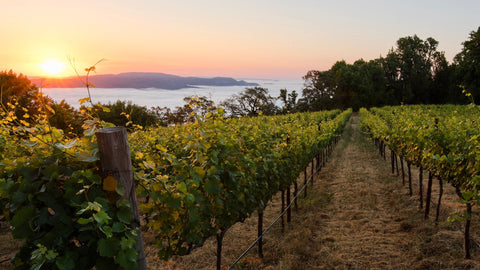America's Organic Wines
California is a great place to start if you’re new to our nation’s most-precious wine style.
By Jenny Adams
Balance.
That word packs a punch, when you consider your life. There’s a work-play balance, and balancing the budget. There’s balancing time at home and time for travel; time with friends, and important memories made, solely with the family.
“I’ve learned you can’t have everything, and do everything, at the same time,” Oprah Winfrey once famously said. The quote sums up a lot––mainly that sacrifices must be made to achieve a well-rounded, balanced existence.
In our dedication to Balance with this Vices box, we began to consider the indulgence of fine wine.
It’s good to balance days off drinking with those you imbibe. That’s no shock to anyone. Yet, what if you could add a healthier wine into your times of slight, delicious vice?
Any time we can tip the scale towards better health, you’d better believe we are doing it. What if we were also helping the planet at the same time? It seems a no-brainer.
Enter: Organic Wines. Better for the earth, better for your body, focused on flavor, achieved through optimal farming practices.
Why aren’t we seeing more of them flying off shelves?
It goes deeper than the cost of making them. Seventy-five-percent of organic wine options come from Europe and only two-percent from California and a lot of that comes down to, yes, cost. But also to sulfites––particularly those that might keep a wine fresh longer in your wine rack.
What Are Organic Wines?
Organic means something different when it comes to wine, versus food. It’s different when you are speaking about Canadian or European wines, versus American.
An organic wine in America must be produced with organically grown grapes. A vineyard owner must also implement specific practices –– like refusing added sulfites –– in the final product. Additives, however, are accepted in American organic wines, and can include yeast, egg whites or animal enzymes. Therefore, labeling a wine organic from California or for Oregon, does not mean it’s vegan. In Europe, the laws allow for sulfites, meaning the flavor will not deteriorate quite as quickly in the bottle.
If you want to be strict in your hunt for American and Organic when it comes to your wine, look for the USDA stamp of approval.
Under the USDA National Organic Program all of these certified wines begin with rules that state the grapes must be grown, handled and processed in accordance with uniform national standards.The entire production cycle, from the grapes grown and harvested to the aging process in the barrels, is done in a manner protecting biodiversity, preserving ecological balance, and using unadulterated ingredients.
Learning What You Love in Organic
Like any quest to get more acquainted with a style of wine––be it Pinot Noir from Oregon or bright, refreshing Riojas from Spain––you need the balance of time. Head to a reputable wine shop and select a few bottles. Taste at home. Pause. Let the bottle breathe and come back to it in a few hours. Invite friends over. Keep it slow and steady, and you’ll naturally (like the wine) open up to understand what it is that keeps you invested in one bottle over another.
3 Outstanding California Options
To give you a head start, we rounded up some advice from bartenders, industry insiders and sommeliers around the country as to great, dependable, beautiful wineries from California.
SOPHIE JAMES
The Sophie James vineyard estate is situated at the very top of Sonoma Mountain, above the Northern California towns of Petaluma and Glen Ellen, with 360-degree views of the San Francisco Bay Area. Sophie James produces wines from organically-farmed Sauvignon Blanc and Pinot Noir, including the estate Pinot Noir and a rosé of Pinot Noir, both of which are allocated exclusively to those who purchase a Sophie James club membership. All Sophie James wines are farmed organically. Owners Sophie and JamesGray believe in the highest standards of winemaking, starting with the health of the vines, the quality of the fruit, and absence of chemicals in the vineyard.

Find out more: https://www.sophiejameswine.com/story
BENZINGER
This producer from Sonoma County is triple certified. They make sustainable, organic and biodynamic-certified wines from a vineyard that’s equally inviting to visit on a tour, thanks to roaming cows and sheep.

They also range in price, making this a fine choice for a large gathering, where a case might be called for.
Examples include Benziger Signature Chardonnay at $34 for the $49 biodynamically certified Benziger Estate Three Blocks cabernet blend.
Find out more: https://www.benziger.com/
EHLERS ESTATE
At 42-acres, this isn’t California’s largest winery by any stretch of the imagination, but it does showcase one of the biggest commitments to sustainable and socially responsible practices. Located in Saint Helena, California, these vineyards are 100-percent organic, and winemaker Kevin Morrisey uses a difficult, but rewarding, holistic approach. The backdrop of an old stone barn filled with stunning eclectic antiques makes it a prime place to spend a weekend afternoon, if you’re in the area.

Find out more: ehlersestate.com
Drink Organics Now
Organic wines from America have a shorter shelf life, due to that zero-sulfite rule. It’s wise to consume them in 3 to 6 months. These are not bottles to leave aging in your cellar, but rather ones to pop and enjoy in the moment of now.
Other Labels Worth Looking For
Flip a wine over and look for additional seals of approval, like ...
SIP Certified: A certification of sustainability for California wines that restricts the use of bad chemicals in vineyards. Find out more: sipcertified.org.
Demeter: Demeter offers organic and biodynamic certifications internationally. Find out more: demeter-usa.org.
